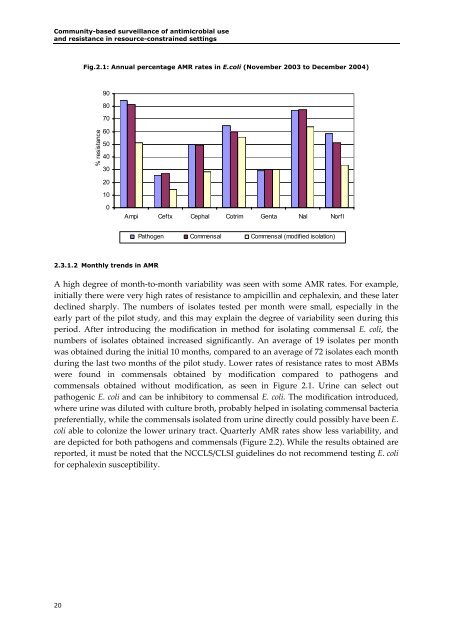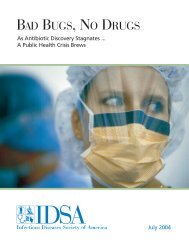Community-Based Surveillance of Antimicrobial Use and ...
Community-Based Surveillance of Antimicrobial Use and ...
Community-Based Surveillance of Antimicrobial Use and ...
- No tags were found...
Create successful ePaper yourself
Turn your PDF publications into a flip-book with our unique Google optimized e-Paper software.
<strong>Community</strong>-based surveillance <strong>of</strong> antimicrobial use<strong>and</strong> resistance in resource-constrained settingsFig.2.1: Annual percentage AMR rates in E.coli (November 2003 to December 2004)908070% resistance6050403020100Ampi Ceftx Cephal Cotrim Genta Nal NorflPathogen Commensal Commensal (modified isolation)2.3.1.2 Monthly trends in AMRA high degree <strong>of</strong> month‐to‐month variability was seen with some AMR rates. For example,initially there were very high rates <strong>of</strong> resistance to ampicillin <strong>and</strong> cephalexin, <strong>and</strong> these laterdeclined sharply. The numbers <strong>of</strong> isolates tested per month were small, especially in theearly part <strong>of</strong> the pilot study, <strong>and</strong> this may explain the degree <strong>of</strong> variability seen during thisperiod. After introducing the modification in method for isolating commensal E. coli, thenumbers <strong>of</strong> isolates obtained increased significantly. An average <strong>of</strong> 19 isolates per monthwas obtained during the initial 10 months, compared to an average <strong>of</strong> 72 isolates each monthduring the last two months <strong>of</strong> the pilot study. Lower rates <strong>of</strong> resistance rates to most ABMswere found in commensals obtained by modification compared to pathogens <strong>and</strong>commensals obtained without modification, as seen in Figure 2.1. Urine can select outpathogenic E. coli <strong>and</strong> can be inhibitory to commensal E. coli. The modification introduced,where urine was diluted with culture broth, probably helped in isolating commensal bacteriapreferentially, while the commensals isolated from urine directly could possibly have been E.coli able to colonize the lower urinary tract. Quarterly AMR rates show less variability, <strong>and</strong>are depicted for both pathogens <strong>and</strong> commensals (Figure 2.2). While the results obtained arereported, it must be noted that the NCCLS/CLSI guidelines do not recommend testing E. colifor cephalexin susceptibility.20




